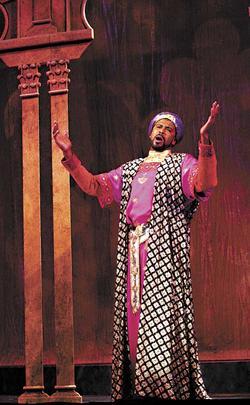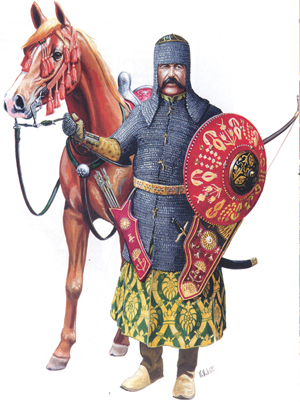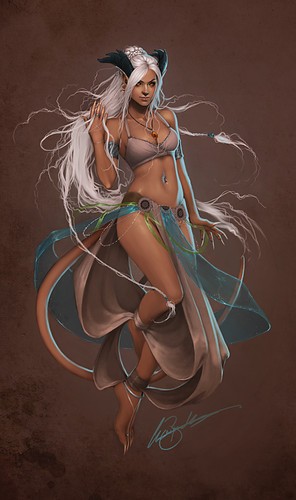 Easily the oldest of the states of Exodus is without doubt the Dominion. Forged in the aftermath of the War of Mind and Magic, the Dominion’s human population intermarried with gevet and foreign colonists from the lands of the Sorcerer-Kings of Abaddon to create a distinct sub-race. The Dominion was formed ten centuries ago when the First Khagan – whose name is unknown to this day – led his people in rebellion against the crumbling empire of the Sorcerer-Kings in a series of surprise raids that showed his military genius. At his death, he left the Dominion with its own alphabet, a clear caste system, a strong military tradition and a people who valued and encouraged their own innate magical talents.
Easily the oldest of the states of Exodus is without doubt the Dominion. Forged in the aftermath of the War of Mind and Magic, the Dominion’s human population intermarried with gevet and foreign colonists from the lands of the Sorcerer-Kings of Abaddon to create a distinct sub-race. The Dominion was formed ten centuries ago when the First Khagan – whose name is unknown to this day – led his people in rebellion against the crumbling empire of the Sorcerer-Kings in a series of surprise raids that showed his military genius. At his death, he left the Dominion with its own alphabet, a clear caste system, a strong military tradition and a people who valued and encouraged their own innate magical talents.
His title of Khagan means Khan among Khans, marking him as the highest leader of the land.
The lands of the Dominion are mostly composed of burning desert lands. Ancient scrolls lead us to believe that the lands were once mostly tundra and massive pine forest. But today’s Dominion is a land that is supernaturally warm. Most believe this to be the result of one of the apocalyptic battles between the Kaga and the First Ones. Others think it is the result of a time-forgotten experiment that led to the creation of the gevet race. The sands keep their secrets well.
Over the last decade, the Dominion has mend ties with both its neighbors. First, all four of the Caneus Emperor’s children were educated in Qijom, this made as a gesture of good faith from both sides. The now-Khagan developed a love affair with now-former Empress Mercy. His brother was sent to the Dominion’s traditional enemy, the Protectorate where he and the Tsarina have developed loving ties. However, the murder of Empress Mercy has made the Khagan
Innate magically ability and magical aptitude is more common in the Dominion that it is anywhere on Exodus. At the founding of the Dominion, this magical aptitude is what created the Khans, magical-filled beings. The Khans controlled vast magical powers. Today, most nobles do possess arcane powers, but many members of the lower castes have also demonstrated the ability. Those who possess innate talents are valued and thought how to master their gift. Certain Dominion spell casters have developed a unique methods to magic they call Wyrdcasting. Wyrdcasters can tap into powers not known or understood by others.
Alone on Exodus, the Dominion have raised a full city into the sky. The floating city of Anidem was fought over many times. Unable to take the city, the Protectorate decided to blast the city to rubble. Today, only the Khan and the rich live in the floating city while the poor live in the rebuilt sections of what was once the rubble.
The Ruling Family
 The current Khagan is Malick Al’Adim. He is a renowned scholar, swordsman and magic wielder. Malick is loved by his subjects as a fair, an even-tempered and patient man. However, since the death of Empress Mercy, he has grown increasingly paranoid and has begun re-arming the Dominion for war. People blame the Khagan’s erratic behavior on the pressure of running such a country.
The current Khagan is Malick Al’Adim. He is a renowned scholar, swordsman and magic wielder. Malick is loved by his subjects as a fair, an even-tempered and patient man. However, since the death of Empress Mercy, he has grown increasingly paranoid and has begun re-arming the Dominion for war. People blame the Khagan’s erratic behavior on the pressure of running such a country.
The Grey Eminence behind the Khagan is his brother, Sultan Nasser. Nasser is a scholar and a famous diviner who does not have his brother’s charisma or strength. Nasser is an ardent patriot who works for the betterment of the Dominion above all. He has close ties with the Sasoris and their information network. It is said that no one can speak the Khagan’s name without Nasser knowing about it. He does have one flaw… He is madly in love with Tsarina Anayanka of the Arman Protectorate. Rumors of marriage between the two were high until the murder of Empress Mercy. Such plans are now on-hold.
The Flavor
The Dominion has a definite Arabic feel: men wear turbans and long robes. Women wear long, shape-hiding clothes. The clothes are generally plain in color or with simple diamond or striped patterns. These are then enhanced with jewelry. Important buildings have minarets, onion-shaped domes, narrow, white-washed buildings. The heat in the Dominion - with few exceptions - is unbearable. Although outfits that are definitely out of place: heavy armor, fur coats, foreign clothing adapted to other climates are not all that uncommon because ready availability of magic and the endure elements spell, many rich or fanciful wear these clothes when they want to.
Though taking from Arabic influences, the Dominion is not united by religion. The Sanguine Covenant, the official religion teaches that evil arcane casters must be destroyed, it leaves extremely vague the notion of what constitutes "evil". Thus many nobles do not actively believe in the teachings of the Covenant. However, the freemen and lower classes actively and strongly support the Convenant as the church protects them from the possible depredations of depraved or degenerate nobles.
 People of the Dominion have dark skin, dark hair and dark-colored eyes. However, on the northern borders, straw and sandy hair is not uncommon. Skin tones lighten near the Caneus Empire and the Arman Protectorate. The intermingling of the Cordelian stock (the Dominion's major human group) with its neighbors over the centuries was caused by constant invasions and warfare. Mixed in with this – and especially closer to the borders, the dress codes changes and introduces foreign elements to the traditional elements.
People of the Dominion have dark skin, dark hair and dark-colored eyes. However, on the northern borders, straw and sandy hair is not uncommon. Skin tones lighten near the Caneus Empire and the Arman Protectorate. The intermingling of the Cordelian stock (the Dominion's major human group) with its neighbors over the centuries was caused by constant invasions and warfare. Mixed in with this – and especially closer to the borders, the dress codes changes and introduces foreign elements to the traditional elements.
For example, I see Dominion dress becoming more like that of Seljuk Turks or Cumans the closer one gets to the Protectorate. Armor becomes more Arman in design and form, so does equipment and weaponry. Since the Abaddon River basin was fought over until Unification (91 year ago), the two groups have cross-breed a lot. Men wear brightly-patterned long shirts over pants. Women keep their hair in long braids with dressed of a pattern similar to their husbands.
In the north, although not as prevalent, the mingling of the Dominion people and those of the Caneus Empire produces a dress and military than resembles mid-era Byzantines. The dress style is based on long tunics, usually of white with the edges died a contrasting color: red, green and purple are the most common. These colorful bands are then embroidered with gold or silver treads. Women carry their hair in up-dos with intricate braids and tiaras.
The Gevet
 The Dominion has the biggest population of gevet (or tieflings) in all of Exodus. Unwelcomed in most part of the world, these part-fiends part-humans have heavily influenced Dominion society. Their influence in the arts (particularly music and dance) is undeniable. Few Khans resist taking a gevet concubine whose promiscuity and libido are legendary. The trick is to woo one and get her away from her family. Gevet are extremely protective of their females and matrons rule entire tribes with an iron fist.
The Dominion has the biggest population of gevet (or tieflings) in all of Exodus. Unwelcomed in most part of the world, these part-fiends part-humans have heavily influenced Dominion society. Their influence in the arts (particularly music and dance) is undeniable. Few Khans resist taking a gevet concubine whose promiscuity and libido are legendary. The trick is to woo one and get her away from her family. Gevet are extremely protective of their females and matrons rule entire tribes with an iron fist.
Male gevet are generally seen as nuisance and criminals. Most of them are. They are found running all types of criminal organizations. Few male gevet are considered useful or active members of society.
The Sasori
An integral part of Dominion society are the sasori. These man-scorpions have served the Khagans since the days of the First Khagan. Dominion authorities have many sasoris in positions of power and part of the military. Indeed, whenever something is deemed extremely valuable, the Sasori are asked to watch over it. Though not every sasori work for the government, few actively work against it. The Khagan is said those be the leader of a secret police made up of sasori.
The Army
 The Dominion army is overall based on the old tribal system. Khans gather to form an army. The core of the army is made up of light cavalry and designed for rapid movement. Its numbers are actually quite small as the Dominion wins its battle through the use of magic. To supplement that, the Dominion employs specialist units, such as Sasori infantry, heavy cavalry fighting (from the the northern Dominion) and gevet assassins. Fighting the Dominion means one should be ready to fight a number of summoned elementals.
The Dominion army is overall based on the old tribal system. Khans gather to form an army. The core of the army is made up of light cavalry and designed for rapid movement. Its numbers are actually quite small as the Dominion wins its battle through the use of magic. To supplement that, the Dominion employs specialist units, such as Sasori infantry, heavy cavalry fighting (from the the northern Dominion) and gevet assassins. Fighting the Dominion means one should be ready to fight a number of summoned elementals.
Because of the large number of spell casters in the Dominion, the Khagan employs a small group of specially-trained assassins known as the Khalid Asad. The Khalid Asad specialize in slaying spell casters.

No comments:
Post a Comment